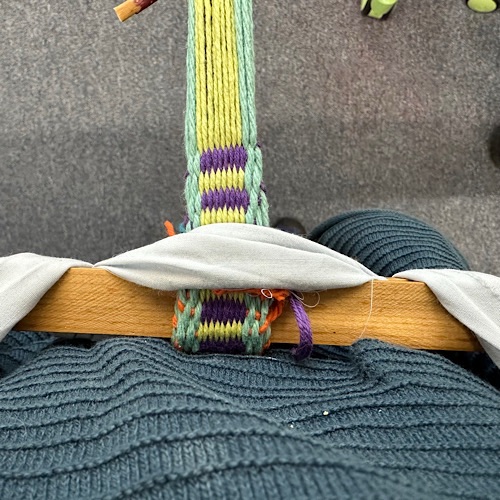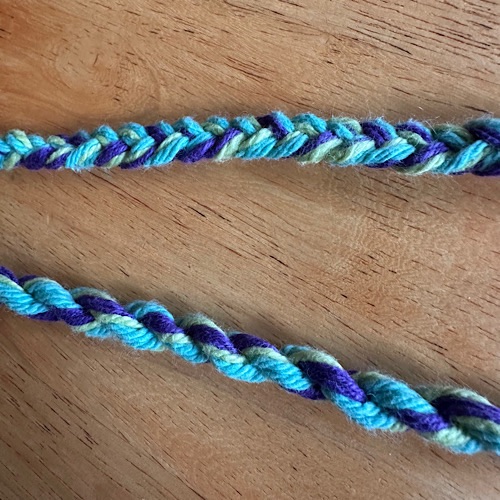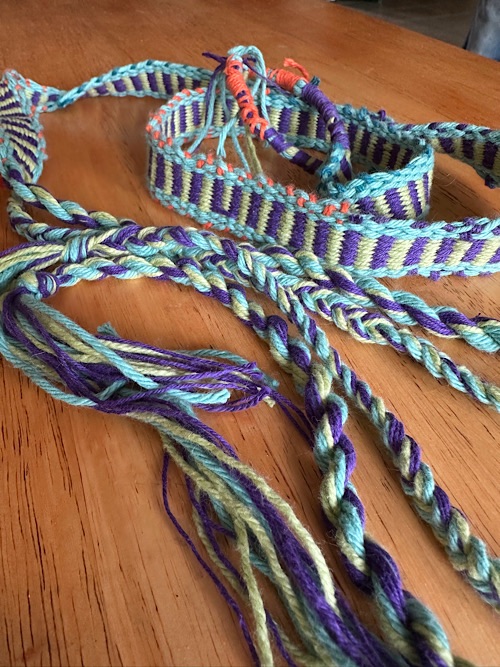Backstrap weaving
Another spring class with Susanne, what a blessing. I watched her do a demo of backstrap weaving at the Common Ground Fair last fall and I realized I needed a lot more instruction to be able to do it. So when I saw she was teaching it at the Adult Ed center, I signed up.
It was a lot of fun. I really enjoy that the body is involved in holding the tension. There is a bit of complicated (to me) setup: winding the warp, setting up the heddles and the shed cord, inserting the “safety” sticks. As well as attaching the warp to the fixed object – in our case, a clamp – and the weaving belt – in our case, a strip of torn cloth.
Creating the weave was very fun and went fast in comparison with tapestry weaving. No picking in our simple version, just opening sheds and sliding the weft through. And warp-faced, so it didn’t matter so much which colors were used in the weft. I think I could learn to like this! There are a few errors in my project and wonky selvedges of course. But I created a very functional belt to use for backstrap weaving.
We learned two methods for securing the growing belt to the body. First, just use a big safety pin to pierce through the looped weaving.

Second, use two flat sticks to roll up a section of weaving, then insert the belt as shown between the sticks and over the top. This felt very stable and secure and I found it easier than fussing with a safety pin.

I finished one end of my warp with a wrapped loop. We learned two ways to finish the other end. One half of my tails are braided and the other half are twisted and plied.

Susanne said the colors are supposed to be gaudy. Someone in class said my colors were Mardi Gras colors.

She brought lots of examples of beautiful projects made with the backstrap. And sent us home with a string of heddles and a short wound warp, plus some weft, for the next project. Compared to tapestry weaving, there’s a lot less pressure to make something artistic. And it’s very simple, doesn’t take up much space like a loom would.
A woman in class was from Romania and she demonstrated in the air how her grandmother used to spin wool from the sheep they raised. She didn’t use a wheel, just a spindle and drafting. And Susanne told the amazing story of Berta’s Flax. Fiber traditions are so comforting to me, and it feels good to be in this continuum, even in my inexpert way.
Catherine~ This is so great! I like that after an enjoyable workshop, you walked away with something useful and additional items to use as well. It was interesting to see the two ends finished so differently. I assumed I would like the braided one best, since I am a braids girl…but I really couldn’t decide. they both look great. Berta’s Flax was a good read. My how things have changed. We went to the local Cowboy Festival today and there was two women there demonstrating ‘carding’ and a drop spindle.
It is a real bonus to have stuff to take home to get the lessons to take hold. I’ve been very lazy today and haven’t done anything, but hopefully next week. I too thought I’d like the braided one best, but am feeling very favorable to the twisted one. I’ll see how they act in use. These old crafts are so worth retaining. I really admire people who are keeping them alive.
It’s great to be able to explore new things and so much better with access to local teachers. I have been intrigued by backstrap weaving but haven’t tried it. I too like the idea of using your body to control tension. Did you have a device to make the sheds? There is a guy who lives several towns away from me that has an etsy shop called TheDancingGoats. (Also on IG under that name.) He studies and recreates a lot of ancient fiber working tools. He sells small rigid heddle pieces that you can use for backstrap weaving. I keep hoping he’ll do a class nearby.
We didn’t use a rigid heddle, but Susanne talked about it. Especially for wool because it is “sticky.” We had a shed cord for one shed and a set of heddles (just a row of evenly spaced knotted loops) for the other shed. (It’s hard to describe…) I have a rigid heddle that I bought a few years ago, but couldn’t figure it out on my own or with YouTube instructions. Maybe with Susanne’s help. She lives close by and is quite willing to have people call on her for help.